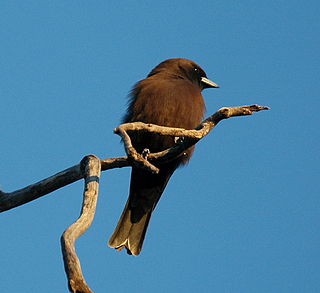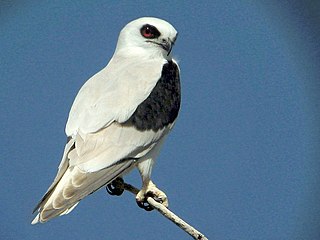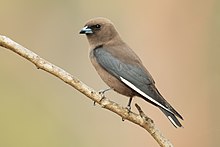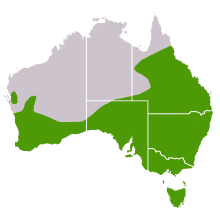
The pied currawong is a black passerine bird native to eastern Australia and Lord Howe Island. One of three currawong species in the genus Strepera, it is closely related to the butcherbirds and Australian magpie of the family Artamidae. Six subspecies are recognised. It is a robust crowlike bird averaging around 48 cm (19 in) in length, black or sooty grey-black in plumage with white undertail and wing patches, yellow irises, and a heavy bill. The male and female are similar in appearance. Known for its melodious calls, the species' name currawong is believed to be of indigenous origin.

The white-breasted woodswallow is a medium sized passerine bird which breeds from the Andaman Islands east through Indonesia and northern Australia. The name "woodswallow" is a misnomer as they are not closely related to true swallows. Instead, they belong to the family Artamidae, which also includes butcherbirds, currawongs and the Australian magpie.

The white-browed woodswallow is a medium-sized (~19 cm) passerine bird endemic to Australia. The white-browed woodswallow has very distinctive plumage consisting of white brow over a black head with the upper body being a deep blue-grey and with a chestnut under body. The females are paler then the males. The white-browed woodswallow has a bifurcated (divided) tongue like most woodswallows.

The little woodswallow, is a bird patchily distributed over much of mainland Australia, avoiding only the driest deserts and the area within about 300 kilometres of the southern coastline, and showing a preference for rugged terrain around inland ranges.

The black-faced woodswallow is a woodswallow of the genus Artamus native to Australia, New Guinea and the Sunda Islands, including Timor. It is 18–19 cm (7.1–7.5 in) long and is the most widespread species in the family Artamidae. Woodswallows have a soft call with chiff, chap and chattering calls which can include vocal mimicry

The Australian owlet-nightjar is a nocturnal bird found in open woodland across Australia and in southern New Guinea. It is colloquially known as the moth owl. It is the most common nocturnal bird in Australia, and despite suffering from predation and competition by introduced species it is not considered threatened.

The dusky-capped flycatcher is a passerine bird in the tyrant flycatcher family. It breeds in forest and other woodland from southern Arizona, as well as the Chisos Mountains, Texas, south to northern Argentina and on Trinidad. It is resident in most of its range, but American breeders retreat to Mexico in winter.

The ashy woodswallow, sometimes also called the ashy swallow-shrike, is a woodswallow which is found in south Asia. Like other woodswallows, it has a short curved bill, a short square tail and long wings. It is usually seen perched in groups, high on powerlines, tall bare trees and most often in areas with a predominance of tall palm trees.

Hammond's flycatcher is a flycatcher in the family Tyrannidae. This small insectivorous bird inhabits the coniferous and mixed forests of western North America. The name of this bird commemorates William Alexander Hammond who was the surgeon general of the US Army. Hammond collected bird specimens for Spencer Fullerton Baird.

The American gray flycatcher, or American grey flycatcher, or just gray flycatcher as it is known in North America, is a small, insectivorous passerine in the tyrant flycatcher family. It is common in the arid regions of western North America, especially the Great Basin. From sagebrush steppes to pinyon-juniper woodlands and ponderosa pine forests, this flycatcher forages for insects from shrubs or low tree branches.

The letter-winged kite is a small, rare and irruptive bird of prey that is found only in Australia. Measuring around 35 cm (14 in) in length with a wingspan of 84–100 cm (33–39 in), the adult letter-winged kite has predominantly pale grey and white plumage and prominent black rings around its red eyes. It gains its name from the highly distinctive black underwing pattern of a shallow 'M' or 'W' shape, seen when in flight. This distinguishes it from the otherwise similar black-shouldered kite. This species is also the only nocturnal species within the order Accipitriformes despite few differences found in its visual anatomy to other closely related kites.

The pied monarch is a species of bird in the monarch-flycatcher family, Monarchidae. It is endemic to coastal Queensland in Australia.

The great woodswallow, also known as the greater woodswallow, giant woodswallow or New Guinea woodswallow is a species of bird in the family Artamidae. As its name implies, it is the largest member of the genus Artamus, averaging 20 centimetres (7.87 in) in length and 61 grams (2.2 oz) in mass. In appearance the great woodswallow is very similar to the more widespread white-breasted woodswallow but can be distinguished by its darker black upper side plumage and by the presence of a semi-oval black patch below the throat.

The Fiji woodswallow is a species of woodswallow in the family Artamidae. It is endemic to most of the islands of Fiji, although it is absent from Kadavu Archipelago and the Lau Archipelago. The species was once considered a race of the white-breasted woodswallow, which breeds from Australia, New Caledonia and Vanuatu through to Borneo and the Philippines. Some authors retain it in that species.

Masked woodswallow is a species of bird in the Artamidae family.

Artamidae is a family of passerine birds found in Australia, the Indo-Pacific region, and Southern Asia. It includes 24 extant species in six genera and three subfamilies: Peltopsinae, Artaminae and Cracticinae. Artamids used to be monotypic, containing only the woodswallows, but it was expanded to include the family Cracticidae in 1994. Some authors, however, still treat the two as separate families. Some species in this family are known for their beautiful song. Their feeding habits vary from nectar sucking (woodswallows) to predation on small birds.




















